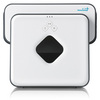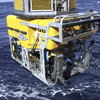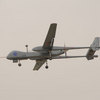Accuray Boeing Colin Angle Consumer Robotics CyberKnife CytoCare DARPA Education Financial Results Health Robotics Healthcare Robotics i.v.Station Industrial Robotics Industrial robotics International Space Station iRobot Liquid Robotics Lockheed Martin Medical Device Medical Robotics Medical robotics medical robotics Military Robotics Military robotics NASA Northrop Grumman Oceanography PackBot Remotely Operated Vehicle Research Robot Robotics ROV Schilling Robotics UAV Unmanned Aerial Vehicle unmanned aerial vehicle Unmanned aerial vehicle Unmanned Underwater Vehicle UUV
Boeing in UAV Control Deal for U.S. Air Force
June 14, 2010
Boeing recently announced a three-year, $9.8 million US Air Force Research Lab contract to develop and demonstrate technologies designed to enable multiple small unmanned aerial vehicles (UAVs) to coordinate with each other and a manned airborne control station to more safely and effectively carry out intelligence, surveillance and reconnaissance missions.
The Foxhunt Multi-Small Unmanned Aerial System Cooperative Control Demonstration will leverage Boeing's networked systems expertise and technology advancements to directly support an emerging and challenging U.S. Air Force need.
According to Patrick Stokes of Boeing Research & Technology, "It's part of a grander vision outlined by the Air Force Research Laboratory to include the air launch, command-and-control and airborne recovery of unmanned aerial systems - all from an airborne mothership."
Stokes said the unmanned aerial systems are intended to be an extension of the manned mothership's sensor and weapon suites, improving situational awareness and intelligence, as well as surveillance and reconnaissance reach, allowing for safer stand-off distances.
Adept to Acquire MobileRobots
June 14, 2010
Adept Technology, Inc. , announced a deal to acquire New Hampshire-based, privately held MobileRobots Inc., a company that designs and develops autonomous robot and automated guided vehicle (AGV) technologies. According to an official press release, the terms of the acquisition involve approximately $1 million of cash at closing, plus 763,359 shares of Adept common stock which is subject to vesting conditions, and a contingent cash payment of up to $320,000 after one year for an estimated transaction value of $4.5 million.
Adept President and CEO, John Dulchinos explained the appeal of the acquisition. "With this acquisition, Adept strengthens its ability to develop and deliver highly flexible automation solutions aligned with the needs and demands of our target markets." MobileRobots solutions include individual robots in hospitals, factory floor AGV fleets, and more. The company's autonomous platforms are able to navigate in unstructured environments and provide comprehensive solutions and unmatched flexibility in delivering supplies, components and parts in complex and peopled environments. Jeanne Dietsch, CEO and Co-founder of MobileRobots was very pleased with the decision to join forces with Adept.
Adept President and CEO, John Dulchinos explained the appeal of the acquisition. "With this acquisition, Adept strengthens its ability to develop and deliver highly flexible automation solutions aligned with the needs and demands of our target markets." MobileRobots solutions include individual robots in hospitals, factory floor AGV fleets, and more. The company's autonomous platforms are able to navigate in unstructured environments and provide comprehensive solutions and unmatched flexibility in delivering supplies, components and parts in complex and peopled environments. Jeanne Dietsch, CEO and Co-founder of MobileRobots was very pleased with the decision to join forces with Adept.
Wind River Chosen for Radioactive Cleanup Robots
April 26, 2010
Wind River announced that VxWorks is the choice of the France-based Group of Robotic Intervention on Accidents (INTRA) for its new family of radioactive cleanup robots.
The robots are equipped with cameras and radioactivity sensors, and are designed to assess and clear radioactive accidents.
The control units in the robots and in the control center run VxWorks on an Intel Pentium 4 processor. According to a Wind River press release, the system needs a response time of less than 100 milliseconds for all the data and three channels of high-resolution video from the robot, including startup time, and the software must be highly deterministic to reliably handle all operations and give the operator real-time control.
The INTRA vehicles that are the first in line for VxWorks are the ERASE, EBENNE, and ERELT robotic vehicles.
· The External Reconnaissance, Assistance and Surveillance Robot (ERASE) is designed to inspect accident sites remotely. It can navigate rough terrain and be controlled from up to 10 kilometers away for up to ten hours.
· The Engin Benne, or EBENNE, is a dump truck equipped with cameras, lighting and a gamma detector to enable precise remote operation around the clock.
· The Teleoperated Relay Robot (ERELT) is fitted with a telescoping antenna and relays radio transmissions from the ERASE and EBENNE to a control desk, located a safe distance away.
Describing the choice of Wind River, Pascal Izydorczyk, Technical Operations Attache at INTRA Groupe said, "The INTRA Groupe robots are designed to operate under the most hostile conditions possible. A real-time response is necessary from the equipment when lives may be in danger and every second counts.
DARPA Loses Hypersonic Bird
April 26, 2010
The Defense Advanced Research Projects Agency (DARPA) is deploying its engineers to solve the riddle of why its Falcon Hypersonic Technology Vehicle 2 (HTV-2) stopped sending data just nine minutes into its mission.
According to the Agency, the Minotaur Lite launch system did what it was supposed to, namely deliver the HTV-2 glide vehicle to desired altitude, execute a series of energy management drills, break free of the clamshell fairing, and launch the HTV-2. However after approximately nine minutes, the vehicle experienced a terminal signal loss. According to the DARPA Web site, the Falcon program objectives are to develop and demonstrate hypersonic technologies that will enable prompt global reach missions. The technologies include high lift-to-drag techniques, high temperature materials, precision navigation, guidance, and control, communications through plasma, and an autonomous flight safety system.
According to the Agency, the Minotaur Lite launch system did what it was supposed to, namely deliver the HTV-2 glide vehicle to desired altitude, execute a series of energy management drills, break free of the clamshell fairing, and launch the HTV-2. However after approximately nine minutes, the vehicle experienced a terminal signal loss. According to the DARPA Web site, the Falcon program objectives are to develop and demonstrate hypersonic technologies that will enable prompt global reach missions. The technologies include high lift-to-drag techniques, high temperature materials, precision navigation, guidance, and control, communications through plasma, and an autonomous flight safety system.
ISS: Guess Who's Coming to Dinner?
April 26, 2010
NASA is making plans to send their Robonaut (or R2) robotic assistant to the International Space Station where it will become a permanent fixture, in preparation for eventually working alongside humans be it in space-based research activity or back on Earth in manufacturing settings.
R2, which was developed by NASA in tandem with General Motors (GM) weighs 300 pounds and consists of a head, torso and two arms and two hands. The soon to be ISS denizen will hitch a ride on the space shuttle Discovery as part of NASA's STS-133 mission, currently scheduled for September 16, 2010. This is scheduled to be the penultimate space shuttle mission.
R2 will be tested in microgravity and subjected to various radiation and electromagnetic interference environments.
According to John Olson, director of NASA's Exploration Systems Integration Office at NASA Headquarters in Washington, "This project exemplifies the promise that a future generation of robots can have both in space and on Earth, not as replacements for humans but as companions that can carry out key supporting roles. The combined potential of humans and robots is a perfect example of the sum equaling more than the parts.
BattleBots Documentary: Support a Robotics Filmmaker
March 17, 2010
I recently received a note from Joey Daoud, a documentary film maker who's working on a project focusing on high school BattleBots. He's been following multiple high school robotics teams in South Florida for his project "Bots High" since last August, and he's looking to raise some funding to deploy a multiple camera crew to film the upcoming National Championship.
If you're interested in more information regarding pledging support, check out the project's fundraising site and what "goodies" you might qualify the varying levels of donation. You might even see your name in lights as an associate producer if you pledge enough funds.
Or you can get yourself a copy of the DVD (upon project completion) signed by the director.
In any event, I urge you to check it out and judge for yourself.
Kratos Lands Task Order to Support UAV Predator/Reaper Acquisition
March 17, 2010
Kratos Defense & Security Solutions, announced the receipt of a task award to its Huntsville, Alabama-based Madison Research Division for work related to the acquisition of the Predator and Raptor unmanned aerial vehicles. The value of award is in excess of $1.8 million.
Under this award, Kratos will provide management, support and subject matter expertise in support of the 303 AESW, Reconnaissance Systems Wing.
Earlier this week Kratos announced a nearly $5 million award to provide a low-cost solution to support the AEGIS Ballistic Missile Defense (BMD).
According to a release announcing the award, the Naval Surface Warfare Center Port Hueneme Division White Sands Detachment (NSWC PHD Det WS) has a requirement to engineer, integrate and flight test a family of sub-orbital rockets to be used as diagnostic, tracking and target vehicles. Kratos will evaluate the suitability of combining a surplus Pedro rocket with the Oriole rocket as well as assess other alternative rocket systems, and support up to four launches of these rocket systems.
Boeing's Phantom Eye Propulsion System Passes Key Testing Phase
March 8, 2010
Phantom Eye is not the next installment in the James Bond movie franchise. But that doesn't mean it's any less exciting.
It's Boeing's first unmanned, liquid-hydrogen powered, high altitude long endurance (HALE) aircraft, which will feature a 150-foot wingspan and be capable of flying for more than four days at altitudes up to 65,000 feet while carrying a payload of up to 450 pounds.
"The essence of Phantom Eye is its propulsion system," said Darryl Davis, Boeing Phantom Works president. "After five years of technology development, we are now deploying rapid prototyping to bring together an unmanned aerial vehicle [UAV] with a breakthrough liquid-hydrogen propulsion system that will be ready to fly early next year."
The propulsion system (engine, turbo chargers and engine control system) successfully completed an 80-hour test in an altitude chamber on March 1, clearing the way for further development of the project.
Phantom Eye is designed to carry out missions such as intelligence gathering, reconnaissance, surveillance and communication.
Boeing also is developing a larger HALE that will stay aloft for more than 10 days and carry payloads of more than 2,000 pounds, as well as building "Phantom Ray," a fighter-sized UAV that will be a flying test bed for advanced technologies.
"We believe Phantom Eye and Phantom Ray represent two areas where the unmanned aerial vehicle market is heading, and rapid prototyping is the key to getting us there," said Dave Koopersmith, Advanced Boeing Military Aircraft vice president.
Phantom Ray evolved from the X-45C program. It is scheduled to make its first flight in December.
KaZaK to Supply Technology for Boeing UAV Weapons Project
March 8, 2010
Woburn, MA-based KaZaK Composites, Inc., a provider of high value-added composite engineering and design, announced that they are a key supplier to Boeing Integrated Defense Systems for the first phase of a program to demonstrate miniature weapon technology for use on unmanned airborne vehicles (UAV).
KaZaK will provide the airframe for the UAVs, which will provide the housing for electrical and other components within the weapon. Boeing will use its experience on the Joint Direct Attack Munition and Small Diameter Bomb programs to develop the system integration, seeker, avionics, guidance and control, and mission planning systems.
By working with Boeing KaZaK expands upon our relationships with the primes, which now includes most major defense contractors," said John Schickling, EVP/COO of KaZaK Composites, Inc. "Inclusion in this exciting contract continues to demonstrate KaZaK's talent and experience in producing advanced, creative engineering to any number of projects across a wide range of aerospace applications."
Northrop Global Hawk Makes Historic Flight
March 8, 2010
Northrop Grumman achieved yet another milestone when its RQ-4 Global Hawk unmanned aircraft system (UAS) completed a four-hour, round-trip mission, taking off from its Palmdale, CA-based manufacturing facility, reaching cruising altitudes of over 58,000 feet, and safely returning to land at the facility.
According to George Guerra, Northrop Grumman vice president of High-Altitude, Long-Endurance (HALE) systems, "This was the first time ever that the same Global Hawk has taken off and landed in a single mission from Palmdale, heralding a new era of flights in and out of the facility."
This mission marked the eighth consecutive production Global Hawk to complete its operational check flight on the first attempt.
The Global Hawk is fast becoming a prized unmanned system. The platform was recently used in the wake of the earthquakes in Haiti, where it provided over 3,600 images of affected areas.
According to Steve Amburgey, Global Hawk program director for the 303d Aeronautical Systems Group at Wright-Patterson Air Force Base, Ohio, "Logging more than 30,000 combat hours since its first deployment nine years ago, Global Hawk is a highly sought after intelligence, surveillance and reconnaissance system in theater."
BOURBON and Schilling Hail New ROVs
March 8, 2010
Bourbon Subsea Services and Schilling Robotics have announced a new generation of remotely operated vehicles (ROVs) designed for submarine Inspection, Maintenance and Repair of offshore fields.
The HD ROV is well suited both for precision work and for handling loads up to 3000 kilos in waters ranging up to 3000 meters in depth.
Due to the robot's small size, its launch system and tools are easily transportable. They can be quickly sent to the scene of operations as necessitated by the situation. By taking delivery of two, Bourbon Subsea Services plans to take delivery of two additional HD ROVs in the latter half of the year, thus expanding the range of services in its fleet. These newly acquired vehicles will serve as a complement to the existing UHD ROV's (pictured) at Bourbon's disposal.
i.v.Station Outduels RIVA Sterile Compounding Robot
March 8, 2010
TMCnet's Susan Campbell reported last week that Health Robotics' i.v.Station won out in head-to-head tests against RIVA.
The contest comprised the public evaluation of video speed tests between i.v.STATION and RIVA sterile compounding robots, based on each company's public video testimonials at their respective Web sites of an identical powder reconstitution (80ml) and size/dose of syringe (10cc).
According to the report, the i.v.STATION proved to be 3.8 times faster than RIVA, and when considering the RIVA's higher price, i.v.STATION's per-dose price clocks in at an impressive 20 times less by comparison.
The i.v.Station is a centrally-controlled, modular distributed flexible redundant patient-specific intra-venous automation robot for non-hazardous drug preparation, compounding, and dispensing in central pharmacy locations, satellite pharmacies, and even patient care workplaces.
Werner Rainer, Health Robotics' CEO was pleased with the results, although he admitted there was still some room for improvement. A satisfied Rainer was quoted as saying, "I'm happy with i.v.STATION's throughput results in Europe and now in America, especially considering RIVA's 15+ year head-start."
IAI Heron Officially Joins Israel's Air Force
February 25, 2010
Israel Aerospace Industries' (IAI) Unmanned Aerial Vehicle (UAV) Heron TP, also known as the "Eitan", officially entered service into the Israel Air Force (IAF) in a ceremony attended by senior officials of the IAF, Israel Ministry of Defense, and IAI.
Major General Ido Nehushtan, IAF Commander, praised the aircraft's significance on the battlefield, its ability to complete a variety of IAF long-range missions, and its critical role in air force missions covering a broad array of scenarios.
The 'Eitan' joins other IAI UAV systems in use with the IAF, and provides a crucial contribution to IAF operational capabilities. The 'Eitan' will act as the linchpin for the most complex missions the IAF will undertake. IAI UAVs are in service with dozens of nations the world over, and have acquired unprecedented amounts of operational experience.
The 'Eitan' joins other IAI UAV systems in use with the IAF, and provides a crucial contribution to IAF operational capabilities. The 'Eitan' will act as the linchpin for the most complex missions the IAF will undertake. IAI UAVs are in service with dozens of nations the world over, and have acquired unprecedented amounts of operational experience.
Tactile Skin Allows Robots to Feel
February 25, 2010
The most advanced robotic devices being developed these days feature more than just the latest in positioning or vision technology, they also increasingly offer a tactile "skin" that allows them to feel - essentially giving these devices a sense of touch.
TMCnet Sr. Web Editor Patrick Barnard detailed Peratech Limited's contribution to the development of this "robotic skin" designed to allow robots and robotic devices to "feel" touches.
According to Barnard, "The Peratech technology is designed to enable robots to detect not only that they have been touched, but where and how hard."
Central to the development of this breakthrough technology is Peratech's Quantum Tunneling Composites, or QTC materials, which has been used by NASA for its Robonaut device, and by Shadow Robot in the UK, which develops a robotic hand.








